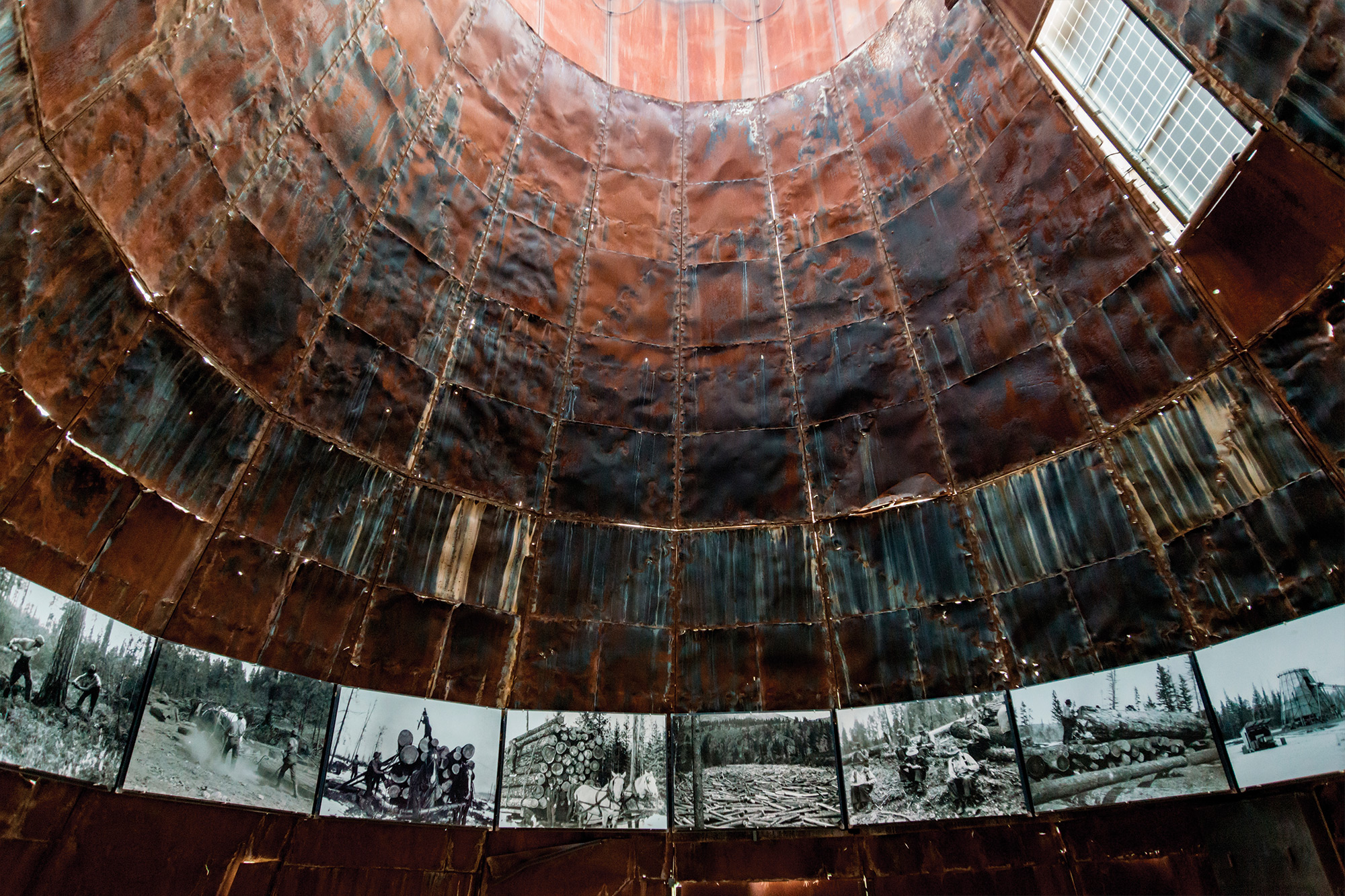
26 Jul Blackfoot Pathways: Sculpture in the Wild
DRIVING INTO LINCOLN, MONTANA, it’s easy to overlook the art installation Blackfoot Pathways: Sculpture in the Wild. But if you mistake, as I did, that grove of ponderosa pine for just another bunch of tall trees, you will have passed by one of the most honest artistic depictions of inspiration and redemption the rural West has to offer.
Lincoln, just over an hour northwest of Helena, appears at first glance to be a narrow strip of dated motels and taverns. Many of Lincoln’s thousand or so residents fondly recall the not-so-distant past when sawmills provided good paychecks and young people didn’t have to leave town to find work. The town’s steady economic decline through the 1980s and ‘90s may not have been big news in the timber-dependent West, but the arrest of Theodore Kaczynski, aka the Unabomber, outside of Lincoln in 1996 was the story of the decade. Lincoln’s community identity became another victim of Kaczynski’s domestic terrorism.
For the last two years, however, a new outdoor sculpture garden, established in September 2014, has been swimming against that tide of reputation and economy.
Rick Dunkerley has lived in Lincoln for more than 20 years. His resume reads like any person who tries to stick in a small town: logger, rancher, wilderness hunting guide, maker of knives. Dunkerly’s richly patterned Damascus folding knives are sold in art galleries more often than sporting goods stores, and he’s a sought-after instructor in the art world. The most recent addition to his resume? Executive director of Blackfoot Pathways: Sculpture in the Wild.
The park’s entrance eluded me, so I stopped into the Lincoln ranger station to ask for directions. The woman at the front desk pointed with a wink across the two-lane highway. The understated sign, parallel to Highway 200, led me down a narrow gravel road into a stately grove of large ponderosa with bark the color of mahogany. I immediately spotted Dunkerley in the dusty parking lot. Instead of the shorts, T-shirt, and sandals the hot day invited, he was wearing the pressed jeans, sport coat, best boots, and the clean cowboy hat that working men like him wear to funerals, weddings, and church. These 26 acres have become sacred to him.
The story of how Sculpture in the Wild came to be goes back to Seattle and, improbably, Ireland. Back in 2010, Dunkerley was teaching a course on his Damascus technique at Seattle’s Pratt Fine Arts Center. Artist-in-residence and Irish silversmith Kevin O’Dwyer took Dunkerley’s course, and the two became friends. Dunkerley listened to O’Dwyer talk about his involvement in an arts project in Ireland, an installation called Sculpture in the Parklands at Lough Boora. That particular area, perhaps not unlike Dunkerley’s hometown of Lincoln, had been degraded by years of industrial extraction — although in the case of Lough Boora, the extracted resource was peat. O’Dwyer had created environmental art that addressed peat extraction, calling it “industrial archaeology.”
Back home, Dunkerley couldn’t get the idea of a Lincoln sculpture park out of his head. “I kept thinking, what a cool thing for a place to be known for.” He wondered how Lincoln residents would react to the idea of environmental art, so he gathered some of the town’s most prominent citizens together and floated the idea. “Am I crazy to want to do this?” he asked them.
Becky Garland, a Blackfoot Valley native, liked the idea from the start. “Growing up in Lincoln, my family had a retail store, and we saw all the comings and goings of people using the area to recreate. Families were always looking for something to do.” She added that the other longtime residents agreed that Dunkerley’s “cockamamie scheme just might work.”
From those initial discussions, Sculpture in the Wild has grown to include eight installations. Because the park is in a natural, dry, forest setting, with knee-high grass, native shrubs, and the ponderosa’s shed needles and cones scattered across the forest floor, this outdoor gallery invites wandering. Partly by design and partly because the park is so new, the path that leads to each piece is as subtle as a game trail. I clung to my brochure to make sure I didn’t inadvertently miss any of the sculptures.
The starting point was hard to miss, however. The tall weathered metal structure of the teepee burner is even more imposing than the statuesque ponderosa pines. This is O’Dwyer’s signature on the park, Montana Memory: Re-Imagining the Delaney Sawmill Teepee Burner. O’Dwyer explained a bit of the history associated with his piece. “In Ireland,” he said, “we had these giant cooling towers. Here, Lincoln had a teepee burner where logging residue was burned. There was this community memory of that tall burner glowing through the night. These industrial pieces tell the story of men and their families and how they survived in these rugged places.”
When O’Dwyer was ready to disassemble the teepee burner from the former Delaney Sawmill and reassemble the towering structure on the park’s grounds, he was awe-struck when dozens of community members and their heavy equipment showed up to help. In all his years of experience working on similar projects, O’Dwyer said he had never seen such a show of support.
He used red LED lights to mimic the glowing embers of the past. The inside of the structure is spacious enough for a small crowd to gather. I listened to cowboy musician Bruce Anfinson strumming his beat-up guitar and crooning the folksy lyrics of horse logging and homesteading. The interior walls were paneled with large black-and-white photos of logging crews on lunch break and giant logs choked with thick chains. The acoustics were surprisingly good.
Beyond capturing tourists’ attention, Sculpture in the Wild has given the community a new way to come together. “This has been a way to connect the neighbors and old friends of this valley who maybe don’t see eye to eye on everything. It’s been healing for me,” Garland said.
Not only are neighbors connecting with neighbors in Lincoln as a result of the artistic endeavor, but residents are also making new friends from around the globe. O’Dwyer, the park’s curator, selects artists not only for their ability to weave the industrial heritage of a place with its river, trees, and mountain ranges, but also for their adeptness at engaging the community in art education. Reflective of O’Dwyer’s background, seven of the nine sculptors whose work is featured in the park are European. Artists complete their pieces during a three-week residency, responding to the Blackfoot Valley’s grandness with perspective untainted by familiarity. They stay with families in the area, play pool with locals at the Wilderness Bar, and enliven conversations throughout the valley.
When I stepped outside the teepee burner, I saw a pack of elementary school-aged kids running a hundred yards or so in the distance, seemingly disappearing into the powder dry, pine needle-covered ground. The children had discovered the park’s latest installment, the East-West Passage, created by Mark Jacobs and Sam Clayton. The young British artists explained that their lodgepole-lined, zigzag trench was inspired by the westward journey of Lewis and Clark, with a nod toward the diligent miners who settled here in the 1800s.
“We were fascinated by the Lewis and Clark party’s journey of exploration, and once we got to Montana, we noticed these old log cabins falling to pieces. The miners felled trees and propped up these cabins as quickly as possible so they could get on with mining,” Clayton said.
Jacobs was clearly amused with the youngsters’ reaction to his art and the park as a whole. “Art is normally a metropolitan thing,” he observed. “These kids are walking their dogs in the middle of nowhere, next to art that private collectors are paying hundreds of thousands of dollars for in the cities. What we’re witnessing here is the pure joy of playing, and art should be playful. I love hearing, ‘Can we go through again?’”
I lingered at House of Sky, a simple polished steel house shape perched atop lodgepole pine stilts. Irishman Alan Counihan’s interpretation of the iconic Montana memoir by Ivan Doig is mesmerizing in a way that inspired me to revisit Doig’s wonderful text.
Dunkerley stopped in front of Picture Frame by Finnish artist Jaako Pernu. “At first it seems chaotic,” he said of the looming frame that holds a tangle of sticks, assembled so they hold the daylight in a different way, moment by moment. “But as you get closer, there’s depth to it that’s not really apparent until you are right there in front of it. And that is this place.”
- Writer Gina Knudson with Pernu’s “Picture Frame.”
- “Hill and Valley” | Steven Siegel (USA) | Material: 30,000 Pounds of Newspaper, 28 Lodgepole Pines, 400 Pounds of Nails
- The installation, “Montana Memory: Re-imagining the Delaney Sawmill Teepee Burner” by artist Kevin O’Dwyer, above and right, tells the story of the logging industry in the Blackfoot Valley. At its peak, the sawmill employed over 100 men, but closed in 1971. The teepee burner was a verstige of a previous age, repurposed by O’Dwyer into an art piece. The black and white images used in the interior were funded by the Montana History Foundation.
- The installation, “Montana Memory: Re-imagining the Delaney Sawmill Teepee Burner” by artist Kevin O’Dwyer, above and right, tells the story of the logging industry in the Blackfoot Valley. At its peak, the sawmill employed over 100 men, but closed in 1971. The teepee burner was a verstige of a previous age, repurposed by O’Dwyer into an art piece. The black and white images used in the interior were funded by the Montana History Foundation.
- “Picture Frame” | Jaakko Pernu (Finland) | Material: Spruce/Pine | Height: 23’
- “Montana Line Drawing” | Kevin O’Dwyer (Ireland) | Sculptor/Artistic Director/Curator | Material: Mild Steel | Height: 22’
- “East West Passage” | Mark Jacobs and Sam Clayton (UK) | Materials: Lodgepole Pine, Cobblestone | Depth: 4’ 6”; Length: 100’; Width: 24’
- Detail from “Hill and Valley”
- Rick Dunkerley, Kevin O’Dwyer, and artist Brandon Ballengée at “A Gateway of Change.”
- “House of Sky” | Alan Counihan (Ireland) | Materials: Stainless Steel, Steel, Pine | Dimensions: 5’ x 2.5’ x 29’
- Detail from “Of Earth, Of Sky, Of Place Between” | Noellynn Pepos (USA) | Materials: Steel
- Writer Gina Knudson with Pernu’s “Picture Frame.”
- “Hill and Valley” | Steven Siegel (USA) | Material: 30,000 Pounds of Newspaper, 28 Lodgepole Pines, 400 Pounds of Nails
- The installation, “Montana Memory: Re-imagining the Delaney Sawmill Teepee Burner” by artist Kevin O’Dwyer, above and right, tells the story of the logging industry in the Blackfoot Valley. At its peak, the sawmill employed over 100 men, but closed in 1971. The teepee burner was a verstige of a previous age, repurposed by O’Dwyer into an art piece. The black and white images used in the interior were funded by the Montana History Foundation.
- The installation, “Montana Memory: Re-imagining the Delaney Sawmill Teepee Burner” by artist Kevin O’Dwyer, above and right, tells the story of the logging industry in the Blackfoot Valley. At its peak, the sawmill employed over 100 men, but closed in 1971. The teepee burner was a verstige of a previous age, repurposed by O’Dwyer into an art piece. The black and white images used in the interior were funded by the Montana History Foundation.
- “East West Passage” | Mark Jacobs and Sam Clayton (UK) | Materials: Lodgepole Pine, Cobblestone | Depth: 4’ 6”; Length: 100’; Width: 24’
- “Montana Line Drawing” | Kevin O’Dwyer (Ireland) | Sculptor/Artistic Director/Curator | Material: Mild Steel | Height: 22’
- “Picture Frame” | Jaakko Pernu (Finland) | Material: Spruce/Pine | Height: 23’
- Detail from “Of Earth, Of Sky, Of Place Between” | Noellynn Pepos (USA) | Materials: Steel
- “House of Sky” | Alan Counihan (Ireland) | Materials: Stainless Steel, Steel, Pine | Dimensions: 5’ x 2.5’ x 29’
- Rick Dunkerley, Kevin O’Dwyer, and artist Brandon Ballengée at “A Gateway of Change.”
- Detail from “Hill and Valley”




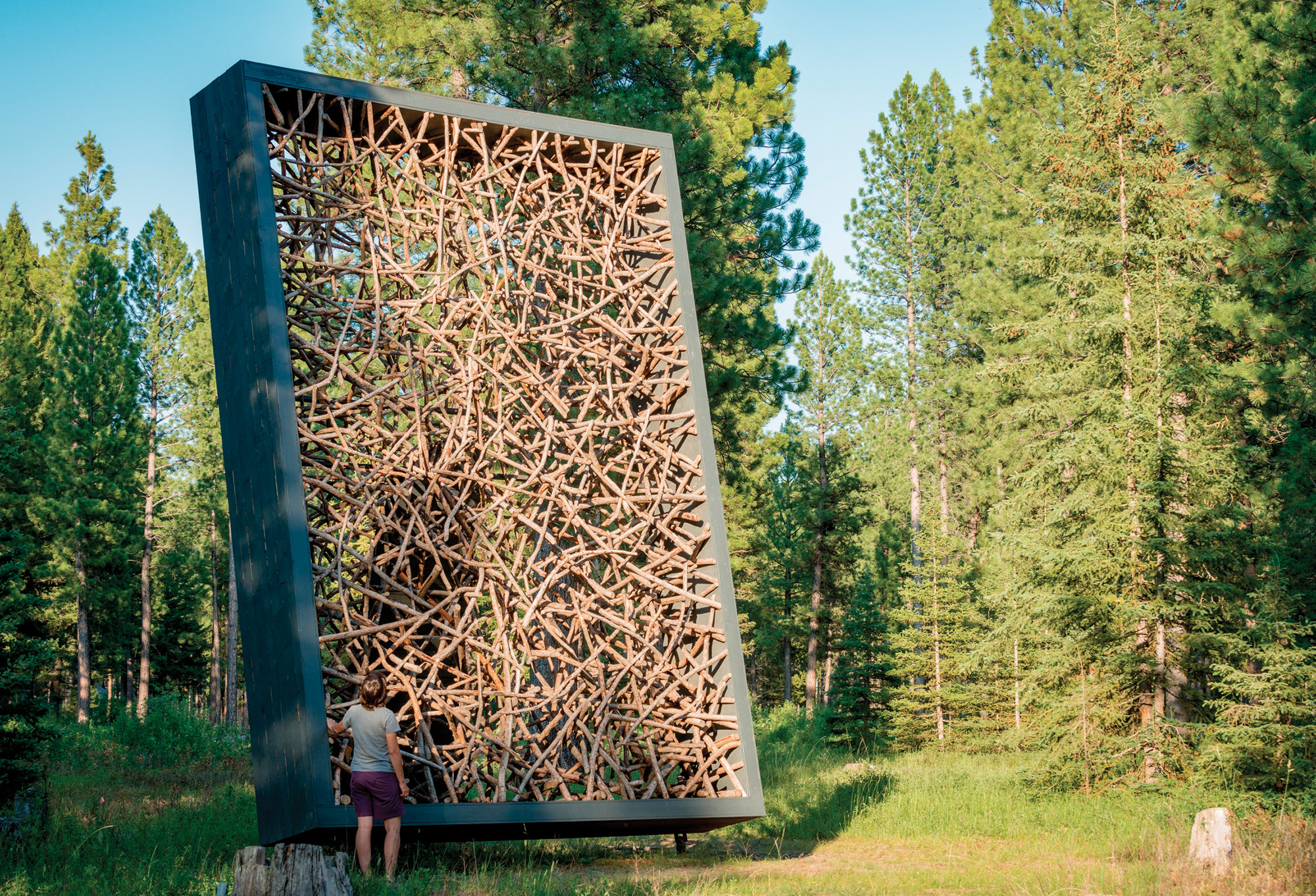



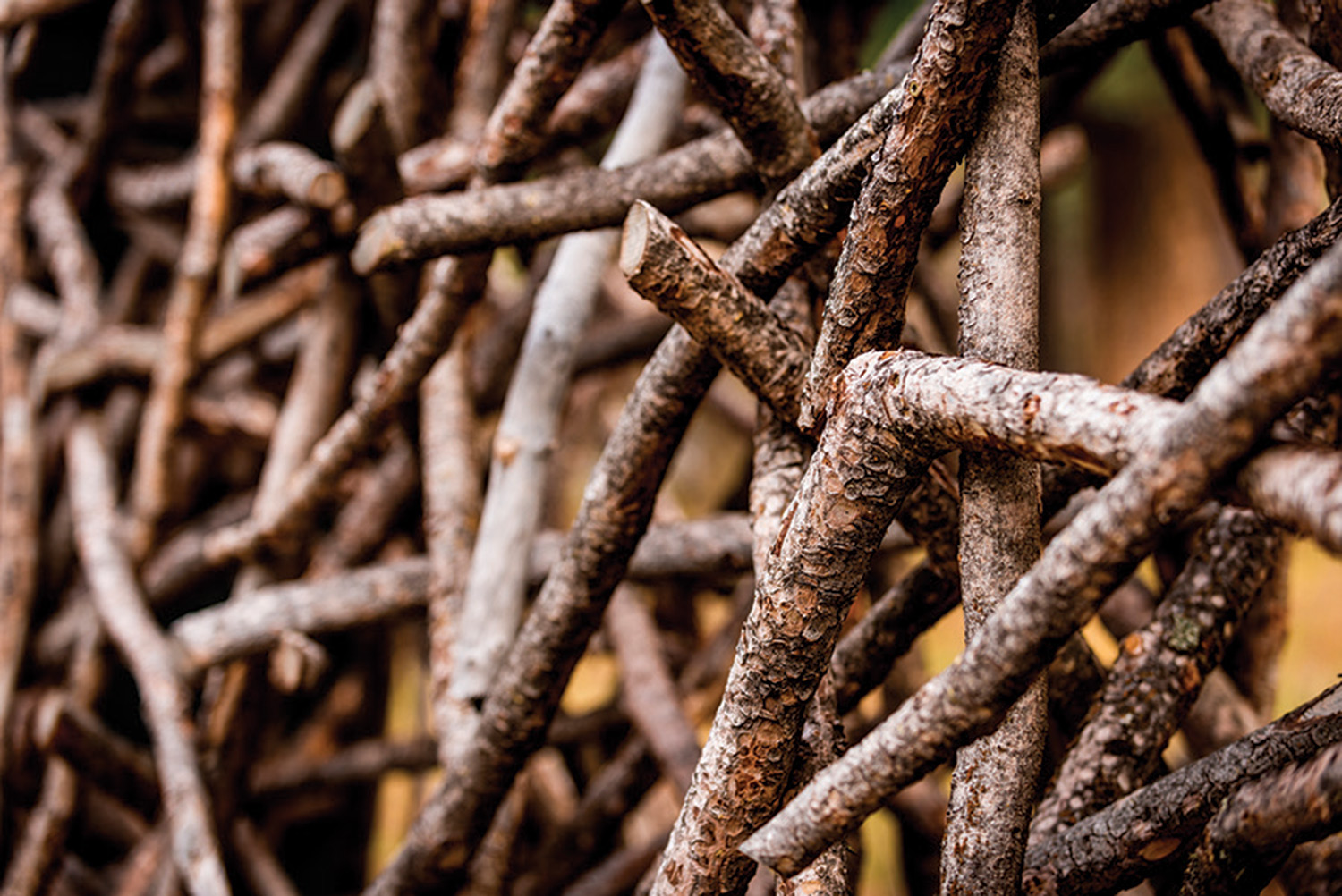
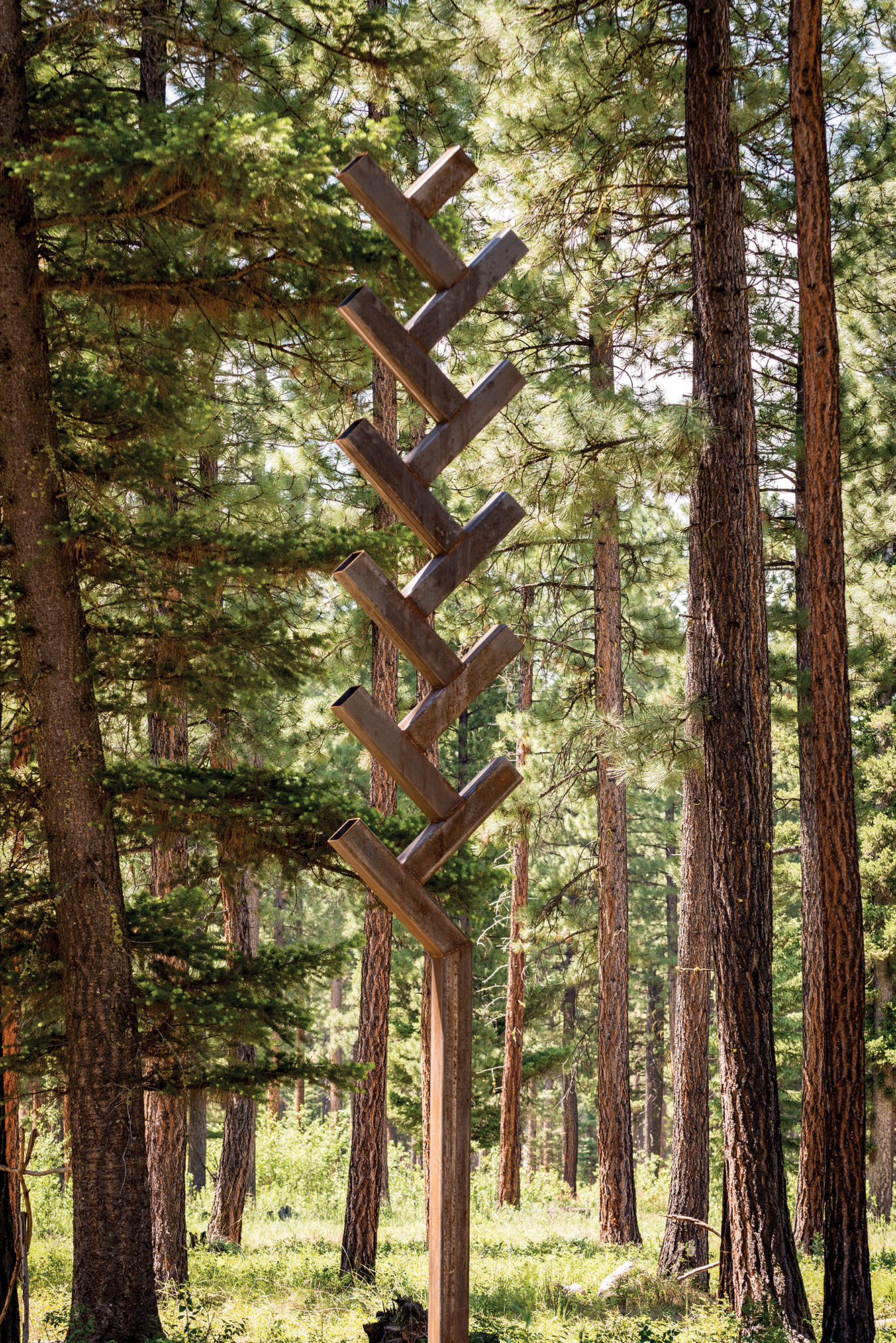
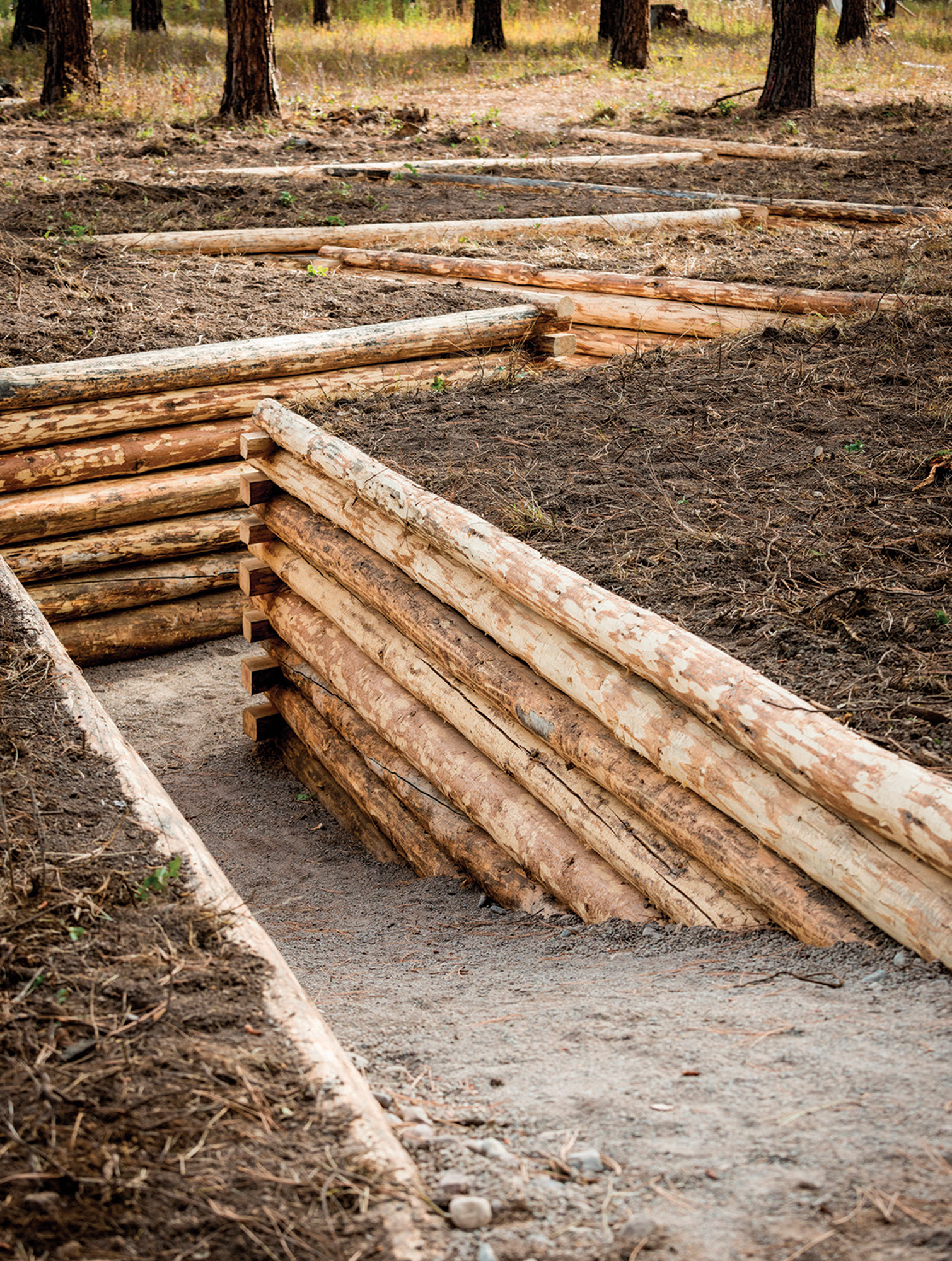
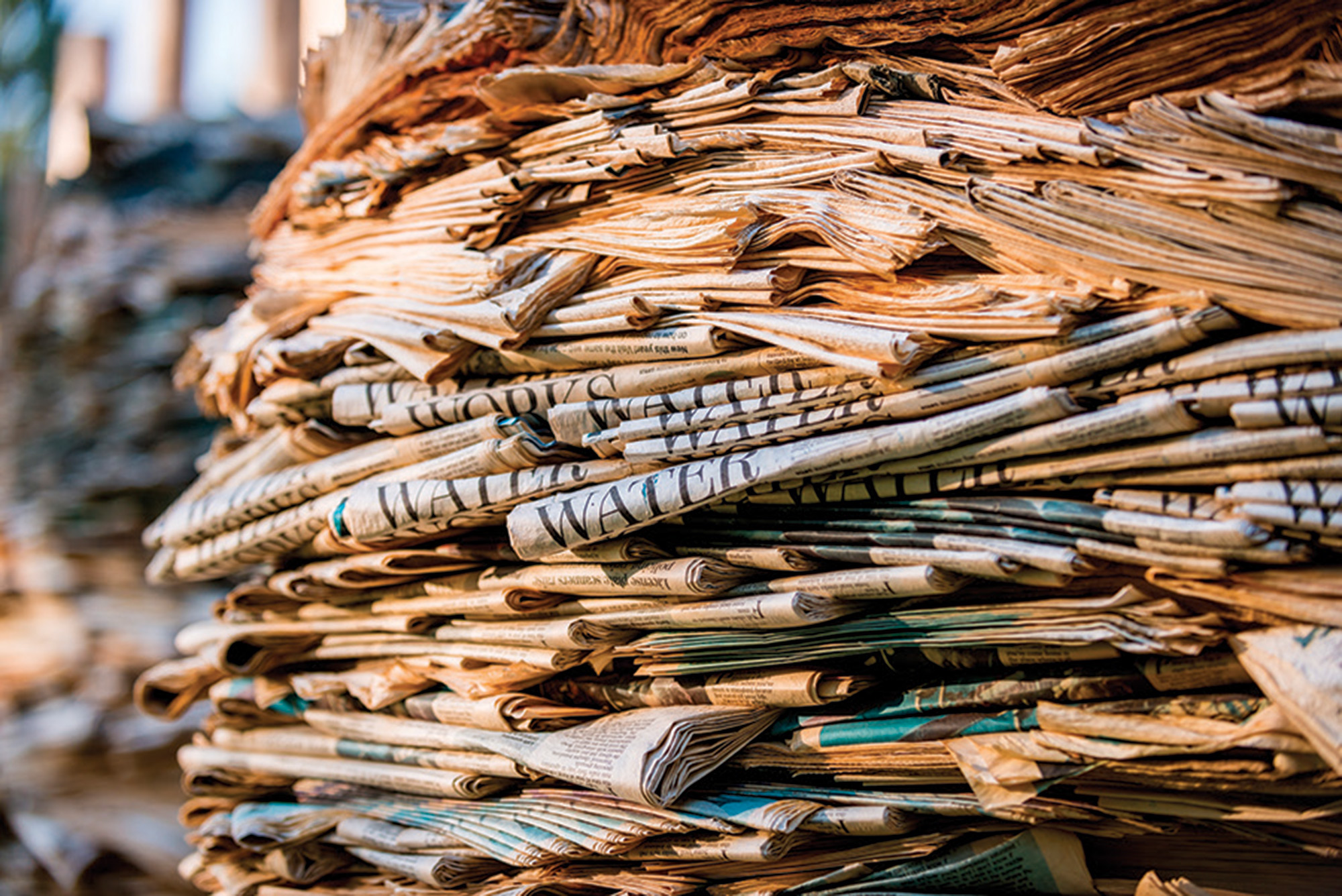
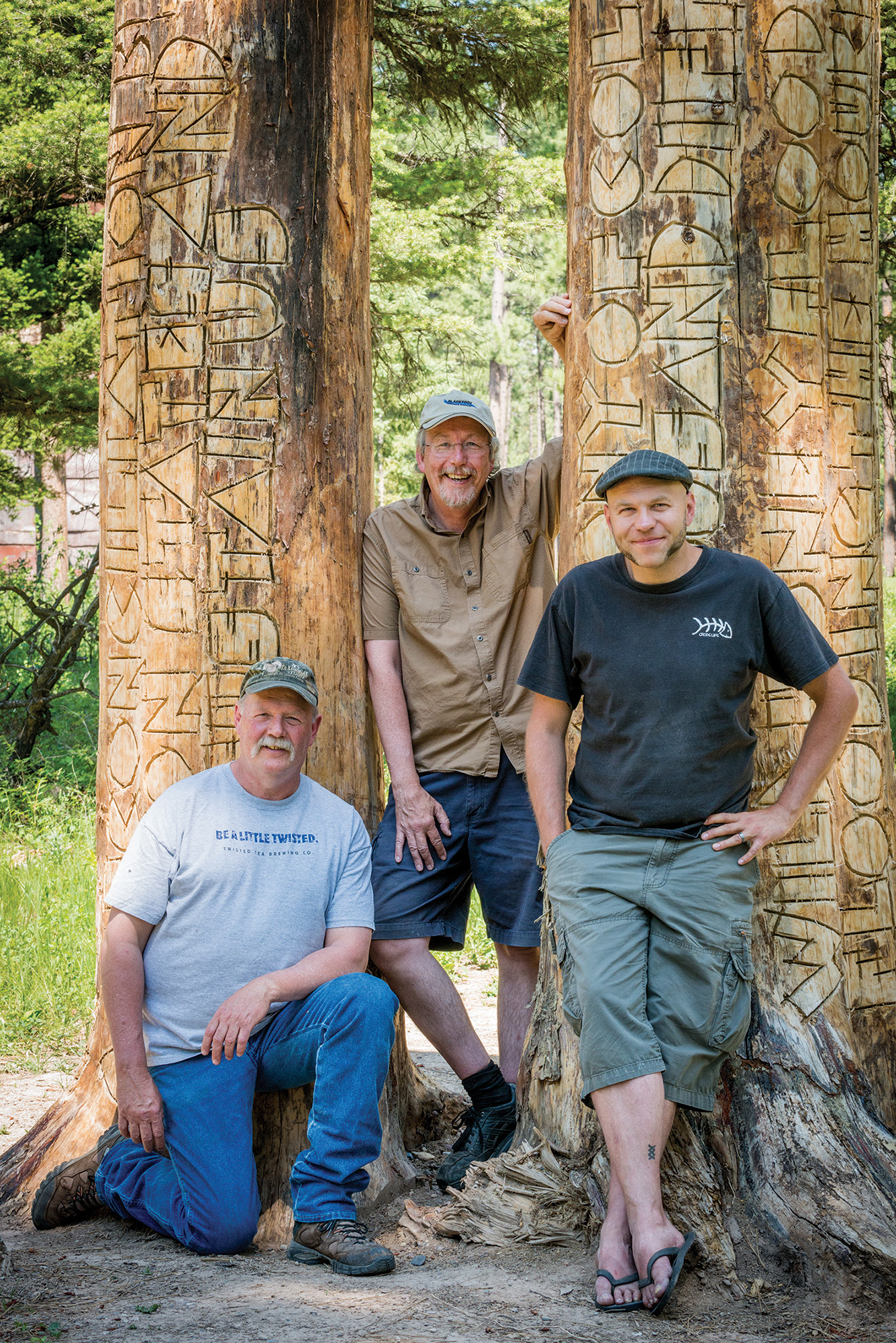


No Comments